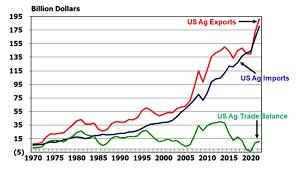 USDA will make available $300 million in funding to support new projects intended to open new markets and to expand existing markets under the Regional Agricultural Promotion Program. The intended allocation is from the $1.2 billion available over a five-year period from the Commodity Credit Corporation.
USDA will make available $300 million in funding to support new projects intended to open new markets and to expand existing markets under the Regional Agricultural Promotion Program. The intended allocation is from the $1.2 billion available over a five-year period from the Commodity Credit Corporation.
Secretary Vilsack stated, “It takes significant investment to open and develop new export markets and this new fund will be dedicated to helping provide start-up capital so that American exporters can diversify their markets and create new opportunities.”
Funding under the Regional Agricultural Promotion Program is available to agricultural trade organizations, U.S. agricultural cooperatives and state regional trade groups operating approved market development activities. In order to concentrate funding on new markets and opportunities, the nations of the E.U. and China, Canada, Mexico will be ineligible for funding. In contrast, emphasis will be placed on Africa, Latin America and the Caribbean and Southeast Asia.
Trade promotion involving undifferentiated commodities can evolve into an exercise of pushing a piece of string. Commodities are purchased in a competitive market environment based on landed cost and the needs of the purchasing nation. For many years, this commentator along with colleagues undertook promotional seminars in Asia and the Middle East on behalf of the American Soybean Association. The premise was that promoting domestic production of eggs and broilers through technology transfer would create more viable poultry industries, creating a demand for soybeans. In many cases, the information did, in fact, help develop industries in India, Pakistan, Thailand, China and the Middle East. The activities of speakers and experts did little to generate goodwill that translated to preferences for the U.S. Importers in host nations understandably sourced soybeans from the best available and cheapest supplier with FOB price, sea freight and seasonal availability being the principal determinants of the purchase decision. An unintended consequence of promotional activities was the inevitable decline in chicken exports to many countries that imposed barriers to imports to protect their emerging industries. The situation was further complicated when U.S. experts were sponsored by commodity associations to present programs on further-processing and packaging thereby creating competition for U.S. exporters in many regional markets. This was ironically to the detriment of the associations’ best customers, the U.S. domestic broiler industry.

Funding the promotion of an undifferentiated commodity by an association may create awareness for a product but this will not necessarily establish a preference for a national supplier. The major U.S. commodity associations have been unsuccessful in identifying superior attributes for GMO corn, soybeans or wheat or establishing quantifiable product differentiation for their commodities among the competing major world exporters.
Considerable progress has been made by industry organizations such as USAPEEC that together with USDA-APHIS have worked to remove artificial trade barriers and to update unrealistic regulations that represented restraints to trade. Local product demonstrations and promotions have increased awareness and demand for turkey, duck and broiler products in Latin America and the Caribbean and in some cases in Asia. This is reflected in direct and indirect benefits for some segments of the industry.
It is hoped that USDA will be able to monitor and quantify the effect of their “investment” in promotion. Public funds are easy to disburse, especially when vast sums of money, that add to the national debt, are made available. USDA intends that the regional agricultural promotion programs should be confined to nonprofits and commodity associations. A more effective and less expensive approach might be to grant tax concessions and other incentives to the private sector to stimulate exports. At the end of the day, neither the U.S. Soybean Association nor the U.S. Grains Council actually sell a single bean or kernel. This is the province of the big five multinational agribusiness conglomerates responsible for the bulk of world trade in commodities.
Is it the intention of the USDA through regional agricultural promotion programs simply to increase the sale of dairy products, endives or similar minor agricultural commodities to Costa Rica and other nations? Is the U. S. taxpayer going to recognize a return on the considerable amount to be assigned to this program? How will it be measured? Who will take responsibility if there is no positive return? Inquiring minds want to know!